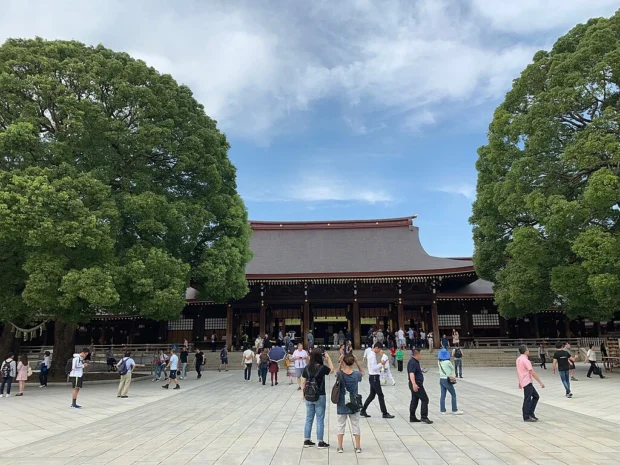When visiting Tokyo, Japan, among the bustling cityscape and neon lights, the peaceful sanctuary of Meiji Shrine offers a unique glimpse into Japan’s rich culture and history. Situated near Harajuku and Shibuya, this Shinto shrine dedicated to Emperor Meiji and Empress Shōken is a must-see for anyone curious about traditional Japan. Travelers often search for directions, visitor tips, historical insights, and guidance on tours or reservations for Meiji Shrine. Nearby, you will find friendly guesthouses and ryokan for an authentic stay, plus local eateries serving delicious sushi and matcha sweets. From Tokyo Station or Narita Airport, several train and bus options bring you close to this spiritual retreat nestled in a vast green forest within the city. Let me take you through the charm, secrets, and practical advice for your visit to Meiji Shrine.
Table of Contents
Finding Your Way to Meiji Shrine
Getting to Meiji Shrine is straightforward but knowing the best routes ensures a smooth start to your visit. The shrine is close to well-known stations in Tokyo, making it very accessible.
Train and Walking Directions
Take the JR Yamanote Line to Harajuku Station, which places you at the shrine’s main entrance. This station connects easily to Shibuya and Shinjuku, major hubs in Tokyo. Alternatively, you can use the Tokyo Metro Chiyoda or Fukutoshin Lines to reach Meiji-jingumae Station, just a few minutes’ walk from the shrine. From Narita Airport, the Narita Express to Tokyo Station, then transfer to the Yamanote Line is a common route.
From Shinjuku Station, it takes about 15 minutes by train to Harajuku Station. After arriving, follow the pleasant wooden torii gates and walk through a dense, peaceful forest path. Even though you are in a big city, the walk feels like stepping into quiet nature. Keep your eyes open for local wildlife such as crow species, which are considered messengers in Shinto mythology.
Why Meiji Shrine Matters So Much
This shrine is more than just a pretty place; it holds deep historical and cultural importance. Dedicated to Emperor Meiji and Empress Shōken, the shrine commemorates their role in the Meiji Restoration, a pivotal period that modernized Japan in the late 19th century.
Emperor Meiji’s Legacy and Shinto Tradition
Emperor Meiji ruled during a time when Japan opened up to the world and transformed from a feudal society to a modern state. The shrine was completed in 1920 as a symbol of gratitude and respect for his contributions. It is designed to honor traditional Shinto beliefs, with rituals and festivals still performed year-round.
One fascinating fact that is often missed is that the entire forest around the shrine was carefully planted by volunteers from all over Japan in the 1920s. Over 100,000 trees from different regions were donated to create this vast green space. This community effort symbolizes harmony between nature and humans, a core value in Shintoism.
Best Times to Visit Meiji Shrine
Choosing the right time to go can change your experience completely. Meiji Shrine attracts many visitors during special festivals and holidays, but the quiet moments feel more special.
Quiet Moments and Festivals to Know
Early mornings on weekdays, especially in the spring or autumn, offer calm surroundings and cool air. Avoid weekends if you prefer solitude. The New Year (January 1–3) is the busiest time, as many locals come for Hatsumode, the first shrine visit of the year. It is lively but crowded.
Throughout the year, several festivals are held, including the Meiji Jingu Spring Grand Festival in May, featuring traditional music and dance. Even during crowds, the atmosphere remains respectful and uplifting.
Planning Your Visit and Tours
Entry to the shrine grounds is free, which is rare for such a famous spot. You can explore independently at your own pace without reservation. However, joining a guided tour adds depth to the visit.
Guided Tours and Reservations
While no ticket is needed, you can book a private guide or join group tours offered by local companies. These tours provide insights into Shinto rites, architecture, and hidden details not visible on casual walks. For weddings or special ceremonies at the shrine, reservations and appointments are required, often made months in advance.
For those exploring Japan’s historical sites, consider seeing Nara’s landmarks and tranquil temples to enjoy a gentler pace filled with nature and tradition.
To see another vibrant Japanese city with unique temples, tasty local dishes, and lively neighborhoods, check out Osaka City Travel Guide.
Don’t miss the treasure house inside Meiji Shrine, where historic artifacts and gifts from foreign dignitaries are displayed. Opening hours usually run from morning till late afternoon.
Local Flavors and Nearby Stays
After immersing yourself in spiritual calm, indulge in local flavors close to Meiji Shrine. The area around Harajuku and Omotesando offers charming cafes and traditional sweets shops serving mochi, matcha tea, and fresh sushi.
Neighborhoods nearby offer cozy guesthouses and traditional inns, providing a chance to rest quietly before returning to Tokyo’s lively districts. Staying close allows early morning visits to avoid crowds and enjoy the peaceful forest walk without rush.
Meiji Shrine’s Official Website
For the latest updates, festival calendars, and visitor information, check the official home page of Meiji Shrine. This resource is handy, offering clear maps, event schedules, and cultural background details to help you prepare your visit well.
Final Thoughts on Your Meiji Shrine Visit
Meiji Shrine provides a rare chance to quiet your mind in harmony with nature right in the heart of Tokyo. Its deep-rooted history, peaceful forest paths, and cultural significance create a memorable experience. Whether you go to witness a festival, participate in rituals, or simply escape city noise, the shrine leaves a lasting impression. Remember to respect customs, take your time walking under the torii gates, and enjoy the surrounding nature. This balance of tradition and tranquility offers something special for every visitor.

A digital nomad exploring cities across the globe, with a passion for local street food and hidden cafes.
- Meiji Jingu Shrine Tokyo Japan by MediaByPanda on Wikimedia Commons – cc by-sa 4.0
